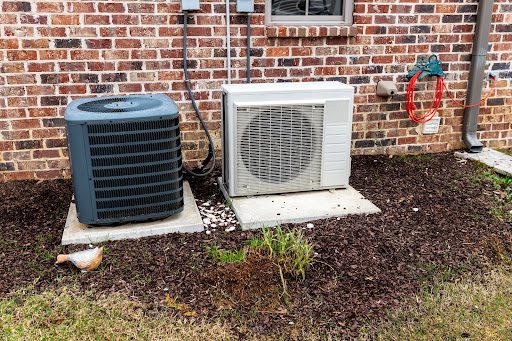
What Are Mini-Split Systems?
Mini-splits are ductless HVAC systems that provide heating and cooling to specific areas or zones in a home. They can be mounted on walls or ceilings, operate quietly, and use advanced filtration systems to improve indoor air quality. Mini-splits are highly energy-efficient and can be installed as standalone systems or to supplement an existing HVAC system. This makes them a great solution for a wide variety of reasons.
Benefits of Mini-Splits
Easy Installation
Mini-splits are relatively easy to install and require minimal construction work, compared to central air systems that require ductwork installation, making them a great solution for homeowners who want to avoid major renovations.
They are a good choice for homes that don’t have ductwork or where only partial ductwork exists. If you’re considering a home addition and you want to avoid the cost and hassle of installing new ductwork, a mini-split is an ideal solution.
Personalized Comfort
Because mini-splits are designed to provide heating and cooling to specific areas or zones in a home, they’re great in homes where homeowners want the ability to control the climate in each zone with ease. A mini-split can heat or cool an area without affecting other areas, providing personalized comfort for each occupant.
Flexible Configurations
Mini-splits are highly flexible and can be installed in a variety of locations and configurations. A mini-split can be mounted on walls or ceilings, and the indoor and outdoor units are connected by a small conduit. Wall-mounted mini-splits are the most common type of mini-split installation. These units are mounted on a wall and connected to an outdoor unit by a conduit that contains the refrigerant line and electrical wiring. Ceiling-mounted mini-splits are mounted on the ceiling and can be a good option for rooms with limited wall space.
Solutions for Standalone Areas
Mini-splits can be installed in unattached parts of a house, such as a garage or a shed, as long as there is a suitable electrical supply and a proper mounting location. In fact, mini-splits can be a great solution for heating and cooling unattached areas, as they can be installed without the need for ductwork, making them a more cost-effective and less invasive solution than traditional HVAC systems.
Better Air Quality
Mini-split systems use advanced filtration to remove dust, allergens, and other pollutants from the air, providing improved indoor air quality. This is great news for allergy sufferers in Austin and those who require advanced filtration due to respiratory problems and more.
How Does a Mini-Split Work?
A residential mini-split consists of an outdoor unit and an indoor unit not dissimilar from a traditional HVAC system. The outdoor unit contains a compressor, a fan, and a coil. The indoor unit contains a fan and a coil. The outdoor and indoor units are connected by refrigerant lines that circulate refrigerant between the two units. The system is easily controlled by a thermostat.
Do I Need an Existing HVAC System to Install a Mini-Split?
You do not need to have an existing HVAC system to have a mini-split installed. Mini-split systems are standalone heating and cooling systems, which means they can be installed in homes that do not have existing ductwork or HVAC systems. This makes them a great option for retrofitting older homes, room additions, or other spaces that are not easily serviced by traditional HVAC systems.
However, if you already have an existing HVAC system, mini-splits can be installed alongside it to provide additional heating and cooling capacity in specific areas of the home. Mini-splits can serve as a supplemental heating and cooling solution to complement an existing HVAC system, or to create a hybrid system that provides the benefits of both a mini-split and an AC or heat pump. This can be a good option for homeowners who want to maximize the energy efficiency and comfort of their HVAC system.
Do Mini-Splits Only Put Out Cold Air?
Mini-split systems are designed to function as both heating and cooling systems, making them a versatile and efficient solution for year-round temperature control. One of the benefits of using a mini-split system for both heating and cooling is that it can be more energy-efficient than using separate systems for each function. Mini-splits also offer greater flexibility in terms of temperature control and zoning, allowing homeowners to heat or cool only the areas of the home that are being used, rather than heating or cooling the entire house.
Can Mini-Splits Work With Heat Pumps?
When used in conjunction with a heat pump, mini-splits can be an effective way to supplement the heating and cooling power of the heat pump, particularly in areas of the home where the heat pump may struggle to maintain a consistent temperature.
In addition, some mini-split systems are specifically designed to be used in conjunction with a heat pump. These systems, known as “ductless heat pumps,” combine the energy efficiency of a mini-split system with the heating and cooling power of a heat pump, resulting in a highly efficient and cost-effective solution for heating and cooling a home.
How to Size a Mini-Split Installation
Determining the correct sizing of a mini-split system is important to ensure that the system operates efficiently and effectively. The size of the room or area that needs to be cooled or heated is a key factor in determining the size of the mini-split system. Room size is typically measured in square feet and is used to determine the cooling or heating capacity required for the system. As a general rule of thumb, a mini-split system requires about 25-30 BTUs per square foot of cooling or heating capacity.
The climate of the region where the home is located should also be considered when sizing a mini-split system. Regions with hotter or colder climates may require a larger system to adequately cool or heat the home.
The insulation of the home is also important to consider. Homes with good insulation may require a smaller system than homes with poor insulation, as they will retain heat or cool air more effectively.
The size and orientation of the windows in the room or area should also be considered when sizing a mini-split system. Rooms with large windows or that face west may require a larger system to combat the additional heat gain from sunlight.
The number of people who will occupy the room or area should also be considered when sizing a mini-split system. Rooms with more people will generate more heat, which may require a larger system to cool effectively.
Are There Any Cons to Installing a Mini-Split?
While mini-split systems offer many benefits, there are also some potential drawbacks to consider. Mini-split systems can be more expensive to install than traditional central air conditioning systems or window units. The cost of the system will depend on the size of the unit, the number of indoor units needed, and the complexity of the installation.
While mini-split systems are typically easier to install than traditional HVAC systems, installation can still be complex and should be performed by a qualified professional. The indoor and outdoor units must be properly sized and located, and refrigerant lines must be carefully installed to ensure that the system operates efficiently.
How Do I Get a Mini-Split Installed?
Mini-split installation involves several key steps, which are typically performed by a qualified HVAC professional. The first step in the mini-split installationprocess is to determine the correct size and design for the system. This involves evaluating the cooling or heating requirements of the space, as well as the location and layout of the indoor and outdoor units.
Once the sizing and design have been determined, the indoor unit is installed. This involves mounting the unit on the wall or ceiling and connecting it to the refrigerant lines and electrical wiring.
The outdoor unit is then installed, typically on a concrete pad or bracket. The unit is connected to the indoor unit with refrigerant lines, and electrical wiring is connected to power the unit.
Refrigerant lines are run between the indoor and outdoor units, typically through a small hole in the wall. The lines are carefully sealed and insulated to ensure proper operation and energy efficiency.
Electrical wiring is run between the indoor and outdoor units, as well as to the power source for the system.
Once the installation is complete, the system is tested and commissioned to ensure that it is operating properly. This involves checking refrigerant levels, verifying electrical connections, and ensuring that the system is providing adequate cooling or heating.
How Much Do Mini-Splits Cost?
The cost of mini-split installation can vary depending on several factors. The more indoor units are required, the higher the cost of installation. The larger the system, the higher the installation cost.
If the installation is complex, such as in a multi-story home or in a tight space, the installation cost may also be higher.
The installation cost of a mini-split system can range from $3,000 to $10,000, with the average cost being around $5,000. This cost typically includes the price of the units, installation materials, labor, and any necessary permits. However, the cost may be higher or lower depending on the specific factors mentioned above.
While mini-split systems may have a higher upfront cost than other cooling or heating options, they can often provide significant energy savings in the long run. Additionally, many mini-split systems are eligible for rebates and incentives from utilities or government programs, which can help offset the installation cost.
